Tuesday, November 26 2013
Perhaps the time has come, or is even past due, for people in the trade, in the societies, and those who are simply enthusiasts to consider a campaign to change the name “Sago Palm” to “Sago Cycad.” On the face of it, it doesn’t seem like it’s any big deal to keep it as is, after all, it’s just a name, right? And a nickname at that.
Well, let’s take a closer look. First of all I can’t tell you how many people in southern California own Sago Palms, but have never heard the term “cycad.” Additionally they don’t realize that they actually own one of the most popular species of cycads in the world. Perhaps many of you have had people ask, “What is a cycad,” but they are familiar with a “Sago Palm.” Or you may have noticed some people who may have heard the word “cycad,” but they just can’t quite remember how to say it, and call it a “cy-ad.” The term “palm” added to the name of perhaps the best known cycad is not only misleading, but does nothing to inform or educate the public that cycads are different from palms.
I am fortunate to be serving on the board of the U.S Cycad Society. I was recently (October 2013) appointed to chair the Education Committee, and after thoughtful consideration, I felt compelled to make one of my first orders of business to start a campaign to correct this longstanding misnomer from “Sago Palm” to “Sago Cycad,” or to use it’s botanical name “Cycas Revoluta.” This simple correction can do wonders to educate the general population as well as those already in the nursery industry. And this is perhaps the first and most important step in helping the public to appreciate these amazing prehistoric plants.
Somehow it seems to be an ironic disservice that the most popular and most well known cycad in the world is saddled with a common name that describes it as a palm. I feel quite certain that there is no palm with a common name that describes it as a cycad. “Sago Palm” was probably coined as a convenient reference term that reflected the plant’s appearance and similarity to a palm, and I believe that there was probably no intent to deceive by early nurserymen and growers when the moniker was adopted. However, at the risk of appearing to rock the boat, I believe that reliable data, when known, should trump all previous data or information, if it is truthful. Nearly all other cycads (with only a few exceptions) are referred to by their botanical name. But if changing the common name of “Sago Palm” to its more descriptive name, “Cycas revoluta,” is just too much to swallow, and is too big of a jump for the general public, who usually prefer the common name, then its reference could always defer to a “new” common name of “Sago Cycad.” This would be botanically appropriate and would help to give the “Sago Cycad” a more appropriate classification in the world of botany.
Grow and Prosper,
Keith
Sunday, September 29 2013
Nurseries and plant specifiers have been promoting the use of drought tolerant plant material in order to feed the seasonal demand by landscapers, homeowners, and collectors. Reflecting back on the last few years of the market shift to a xerophytic emphasis has shown that cycads can hold their own when used in drought tolerant landscape plantings.
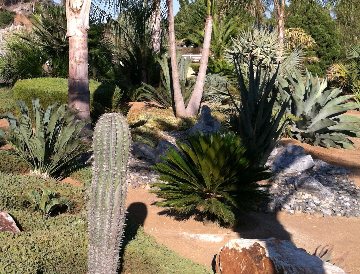
This is, of course, not new information to anyone who has some knowledge of cycad native habitat worldwide. Approximatelyhalf of all known cycad species have significant drought tolerant capabilities. These would consist of cycads whose native habitat is in the dryer regions around the globe. These include many blue Encephalartos species from Africa, many fine leaflet forms of Dioons from Mexico, and many of the Macrozamia species from Australia. Even some species that are native to more tropical or subtropical habitats have shown to be surprisingly resilient when they are established.
Here in southern California many of the larger, more established cycads could actually survive on the seasonal rainfall alone. It is worth noting that larger, more established specimens have developed a mature root system and a significant size caudex (trunk), both of which help to feed and maintain hydration of the plant system during times of drought.
Cycads have proven their versatility when combined with tropical theme landscaping, as well as xerophytic landscape plantings, and they are always able to maintain their own identity.
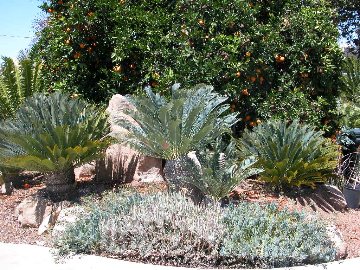
This isn’t to say that all cycads thrive in all positions in the garden. As you study and try various species, you will find that nearly every species would have subtle location preferences if they could make that choice for themselves. As an example, many of the green species of Encephalartos can be grown in full sun if there is significant humidity in the air and little or no seasonal frost. While that same plant, in a dryer, warmer location may benefit from receiving just morning sun for half a day, and then receiving partial or full shade for the remaining part of the day. Plant placement is a subtle but significantly important variable that is worth consideration at the time of planting. As always try to group plants of compatible material that will have similar water requirements.
Grow and prosper,
Keith
Tuesday, August 13 2013
All cycads in cultivation today descend from their ancient ancestors, which grew in the wild. The native habitat for cycads is “the tropical, subtropical and warm temperate regions of both the north and south hemispheres.” (“Cycads of the World” by David L. Jones.) Today the numbers of cycads still thriving in the wild are dwindling; urban encroachment, clearing for agriculture, and poaching being the biggest culprits. Encephalartos woodii is one species which is extinct in the wild. There was only one plant ever found. The last of the stems from the original woodii were transferred from the wild to botanic gardens in 1916. (For a complete list of endangered species of plants and animals see the IUCN Red List of Threatened Species at http://www.iucnredlist.org/ and search cycads.)
Cycads reproduce primarily in two ways. One way is by seed. This process requires a male plant that generates the cone with the pollen, and a female plant with a cone which holds the seeds. Natural pollination is accomplished by native insects (beetles) that carry the pollen from male cone to female cone. In cultivation pollination is often done by man. The second means of propagation is vegetative, or by offset, or pup. Since there was only one woodii ever found in the wild (male), propagation by seed is not feasible, and all true woodiis today are descendants by offset of that original plant from the wild. They are genetic clones of the original plant.
Since most woodiis belong to botanic gardens or private collections, and since cycads are relatively slow-growing, true woodiis rarely become available for sale on the open market. It is not unheard of for collectors to submit their names to a grower to be included on a waiting list to purchase a woodii pup. And still potential buyers may end up waiting many years for the opportunity to own a woodii.
For these reasons offsets of Encephalartos woodii command a hefty price. Viewing an Encephalartos woodii is a rare opportunity, and the opportunity to purchase one of the rarest cycads in the world is even more uncommon.
Grow and prosper,
Laurie
Thursday, July 25 2013
As mid summer approaches, there are many cycad growers on “cone watch.” This is the time of year when cones begin to emerge in our gardens, if fortunate enough to have sexually mature plants. North of the equator cones can begin to emerge between June and August, and usually reach maturity within one to six months from full emergence.
For the intrepid few that choose to try to make their cycads productive and can locate both male and female cones maturing simultaneously, there is a small window of time in which you can assist in the production of viable seed. This involves what is commonly termed “hand pollination.”
Hand pollination can be achieved by delivering pollen into the interior void areas of the female cone when it becomes receptive. This process can be done with dry pollen or adding the pollen to water and pouring that mixture into the void channels of the female cone and repeating the process several times within the perceived period of receptivity at one to five day intervals.
It is important to note that caution should be taken not to use the water method if the female cone does not visibly show any exposed peduncle. The peduncle is the stem of the cone which attaches the cone and the caudex. See photo #1.
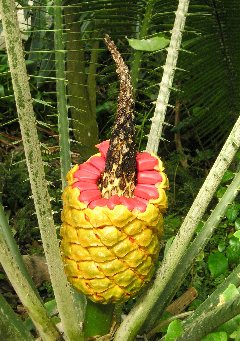
Female encephalartos Vilosus cone joined to the caudex by the peduncle - Wikimedia.org
If there is no peduncle showing, and the cone is tightly nested into and in close contact with the caudex or trunk of the female cycad, the use of water while pollinating should be cautiously undertaken or avoided altogether. See Photo #2.
 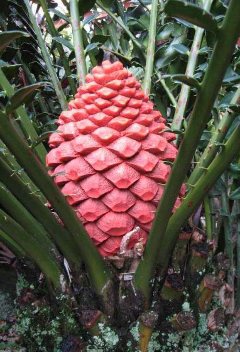
Female encephalartos cone nested in caudex - nzpalmandcycad.org
My first attempt at pollinating any cycad was back in 1978, and I used the pollen/water method. The cone was nested closely to the caudex with no separation showing, i.e. no peduncle. The pollen/water mixture that I was pouring through the cone from the top down was trickling down through the cone and gathering in the top portion of the caudex. Well, as many of us know, standing water in contact with any portion of a cycad is usually a bad combination. After a few months as I was waiting for the cone to mature and break down (dehisce), the cone and the caudex began to turn to mush. My first lesson learned was that water as a pollen delivery system is OK, but the water mixture needs to have a way to drain away from the caudex and not be trapped in the caudex crown.
If the aforementioned condition exists as you are pollinating cones (the female cone is embedded in the nest of the top of the caudex), I would recommend one of the many techniques that involves the use of compressed air to deliver your pollen through your cone as a dry pollen delivery technique.
Grow and prosper,
Keith
Tuesday, June 25 2013
Back in the early 90’s, I had a very close family friend who worked at Roger’s Gardens in Orange County, CA. She knew that I was enthusiastic about growing cycads, and she suggested that I bring some of my cycads to the annual sale that the gardens sponsored in the spring. I took a good selection of material to my display space that was provided. One day when we were discussing the different species of cycads, she was referring at one point to some of the larger size cycads with their myriad shades of green, and she called them “big greenies.” I don’t know if this was her term, or if it was a term common to Rogers Gardens employees when referring to larger foliage plants. That term has stuck with me, and I still refer to any of the non blue species of cycads as “big greenies.” And yes, I do include the appropriate species label.


In my early years of collecting, many of the seedlings that were available, but still relatively scarce, were of the genus Encephalartos, and they were, for the most part, the medium to large green species. As my collection grew and rarer forms became more available, my “big greenies” were reaching a more advanced juvenile stage (not quite full mature footprint). During this period of time, the “blues” (any blue leaf colored cycads) gained in popularity, almost to the exclusion of the green forms all together. I believe that this was partly because most back yards in southern California just didn’t have enough space for a sizeable collection of the larger green form cycads.
The trend for collectors to seek out the blue forms is not without merit, because it is difficult to argue against the logic of collecting any of the striking blue leafed cycad species with their wonderful varieties of leaves and cones.
As I reflect on the material that I have collected, I have no regrets that I acquired material in the order that I did. Although it would be nice to have some of my blues in sizes that approach the size of my “big greenies,” the green species of cycads will almost always grow faster, and be more robust than the blue forms. However, the “big greenies” in their mature form always seem to draw attention in the garden, whereas in more juvenile sizes, they are hardly noticed. The sheer size of mature “greenies” and their fullness and stateliness is what makes the difference.
To give the “big greenies” their proper regard, I can’t imagine not having the considerable variety of green and blues together with their interesting contrasts of color, size, and form. In your gardens and collections, don’t overlook the bold statement that these regal “big greenies” can add, even if you only have room for a few.
Grow and prosper,
Keith
Monday, May 27 2013
In the warmer spring months following a fairly cold January and February, we are happy to see many of our cycads in the ground and in containers begin to push new leaves. This winter we had some very cold temperatures, resulting in many frosty mornings, and even a couple hail storms.
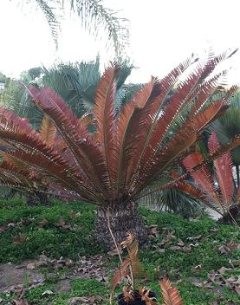 As you might expect, we had a lot of cold damage in the garden. And as a result, March and April of this year, much of my time in the garden was spent removing frost bitten, brown cycad leaves. The damage this year was reminiscent of the damage from “The Winter that Rocked My World”, the blog from December of 2012. As you might expect, we had a lot of cold damage in the garden. And as a result, March and April of this year, much of my time in the garden was spent removing frost bitten, brown cycad leaves. The damage this year was reminiscent of the damage from “The Winter that Rocked My World”, the blog from December of 2012.
But now that leaves have been cut back, it is easy to see how spring rains, sunshine and longer days have done their magic once again, and these hearty plants are pushing new leaf flushes. This is when it is time to give nature a helping hand and pump this growth with fertilizer.
I have made an effort to grow my cycads using as little chemical fertilizer as possible. I really like the idea of growing nearly all of my plants with organic nutrition. The one time of the year that I break with tradition is when I have plants pushing new leaves. I like the fact that the occasional seasonal shot of a water soluble plant food gives the plant immediate access to absorb useful nutrients.
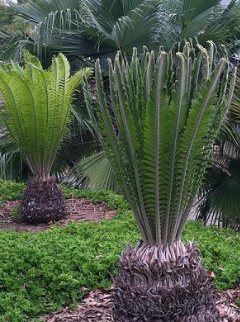
I know that it can be argued that chemical fertilizer can do more harm than good, but I do use it sparingly and primarily during the time of leaf production. The repeated use of chemical fertilizer can deplete and damage many of the beneficial organisms in a healthy soil, but I don’t think that the occasional use will have a devastating effect on the soil.
After leaves have hardened off, my fertilizer applications include mostly organic components. This helps to feed, repair, and replace colonies of micro-organisms in the soil that may have sustained damage from chemical fertilizer applications.
As you can see, I have taken a middle of the road approach to the application of fertilizer. The debate of “chemical or organic” is likely to persist, but in time, each grower will usually settle on what works for him/her. This feeding process has proven successful for me.
Grow and prosper,
Keith
Friday, April 19 2013
There are several things to consider when in the market for cycads as a signature element in your garden.
Understand Value/Rarity and Plant Size/Age
I combine budget and plant size into one heading because they are, for the most part, directly related to each other. When considering separate plants of the same species, if there are no obvious deficiencies or variations, the plant with the largest trunk (caudex) will have greater value. The caudex is the primary means of measure for determining value. The larger the caudex, the greater the value within each species. This rule doesn’t necessarily apply if one is comparing a large specimen of a common species to a small specimen of an extremely rare species. Having some sense of the relative rarity of each species can help the buyer to make a good decision on valuation.
Understand space requirements for mature plants
A mistake that is all too often made is the failure of the grower to adequately understand the mature size of each species being planted. Do your homework. Cycads typically do not produce fully mature leaves until the caudex has developed to approximately 90% of its mature footprint. In other words, mature size leaves are in direct relation to the development of the mature diameter of its caudex or its “footprint.” Learn the mature size of the caudex and leaves by reading or viewing mature plants, in order to gauge their approximate mature size. Leaf size can vary unnaturally if a plant is positioned in too much sun or too much deep shade. Too much sun can make leaves stay more compact (shorter), whereas too much shade can cause leaves to stretch out or extend in their attempt to reach for adequate light.
Choose an appropriate location for planting
Plant placement is a subject that can make or break the impact of a garden setting. I believe that cycads show best if they are given sufficient space to show their form without competing with other plants or architectural hindrances. In other words, give them the space that their mature form will need. This can be very difficult, especially if you are putting several young plants in the ground. Your garden will likely look somewhat sparse for a few years, but as they mature and fill out, your genius will become evident. It is also important to allow plenty of clearance around the anticipated mature leaf size beside foot paths for maintenance, pool access, and whatever pedestrian traffic your garden may experience. In addition don’t forget to leave plenty of clearance overhead. Under decks or eaves is not the best location for taller growing plants. You don’t want to have to remove them when they get big, if possible.
Understand the sun requirements of your cycad(s)
Another aspect of plant placement to consider is the amount of sun exposure or shade protection that each species prefers. In our southern California climate range, if you are planting within 15 or 20 miles of the ocean, most of the cycads available can take full sun. There are a few, however, that would prefer some shade or filtered sun exposure during the hottest hours of the afternoon. Some of the more tropical species do best with a bit more canopy protection. Further from the ocean, some plants may need more canopy protection.
In closing I hope that these recommendations give you confidence in your next cycad acquisition, and help you maximize your cycad growing experience. Remember that there are not too many absolute rules, and what I have suggested are just my take on certain guidelines that I have found to work for me. Be enthusiastic; be bold; and be wise.
Grow and prosper, Keith
Friday, February 15 2013
For those of you who have grown cycads for at least a few years, you probably have heard repeatedly that the most important rule to observe for the successful growth of cycads is to be certain that they are grown in a well draining soil. This is in reality a very general and somewhat relative concept. I know that many growers have different ideas as to how to formulate a good well-draining mix for cycads. I think that there is no one perfect soil mix. More realistically I believe that cycads in general are quite adaptable, and that there is a fairly broad range of well-draining mixes that are well suited to cycad growth.
I basically classify my soil mixes into two general component groups. Group number one includes a variety of mostly inert components that enable the final mix to permit good water drainage. Specifically some of the primary components that allow drainage are: decomposed granite, small size gravel, coarse sand, and pumice. These are crucial, although these components deliver very little in the way of nutrition to nourish the plant.
Number two is a group of materials that are broadly described as naturally occurring organics. These components provide nutrition to the plant by way of microorganisms in the soil which feed on the decomposing organics and help to provide nutrition that the plant can absorb. These components can be a combination of well-decomposed compost, made up of and leaf mulch, small twigs, and tree bark. There are additionally quite a few organic materials that are processed for sale from local nurseries and big box stores. Some of these components are chicken manure, peat moss, oak leaf mold, steer manure, worm casting, etc.
When varying combinations of each of the aforementioned two groups are combined into a final mix that drains well, then you have produced a soil mix that will be suitable for growing cycads.
I have not given an exact proportion of group number one and group number two materials. This is primarily due to the fact that cycad growers don’t agree on any one formula. This tells me that there is a general range of materials that will work well. Combined elements from groups one and two should be tried and proven, and gradually refined for your geographical location and seasonal conditions. The average range for combining groups one and two would be at 50% of group number one to 50% of group number two. This would be a good place to start a mix if you have never made your own mix before. In time you may learn that certain plants may respond if your mix is altered as much as 5% to 25% for either of the two groups. You may alter either of these two groups to gain more drainage in wetter climates or to gain a little more water retention in dryer climates.
If you try this approach I think you can develop a soil mix that will benefit your plants and promote optimal growth.
Grow and prosper.
Keith
Wednesday, January 16 2013
In my experience as a cycad grower I frequently come across individual plants that display a single unusual characteristic that I have never seen associated with that plant in the past. In nearly all cases it turns out to be what I term as an “example of singular occurrence.” To me this means that I don’t remember seeing it happen to that plant in the past, and it hasn’t persisted in successive years, when the plant repeats the same portion of its growth cycle. When I discuss these occurrences with other cycad growers, the typical response from them is that we were observing a mutation.
I decided I needed to look up the definition of mutation. The dictionary defines it as “any heritable alteration of the genes or chromosomes of an organism.” This caused me to think that if what many of us have been characterizing as a mutation, and a mutation involves the “heritable alteration of the genes or chromosomes,” then why are these alterations or deviations not consistently displayed year after year in the plant, as do other genetic characteristics? Perhaps we are not really observing a mutation at all. Perhaps the term anomaly would be more appropriate. The word anomaly is defined as: “Deviation from the normal or common order, form or rule.” I suppose that these two definitions may be interpreted to have some degree of synonymous meaning. However as defined, a mutation can also be considered an anomaly, but an anomaly isn’t necessarily a mutation, because an anomaly doesn’t have to have a heritable change of genes or chromosomes.
Although this term anomaly may be more acceptable, by definition it still suggests no root cause that would describe what, if anything, physically has taken place to cause cycads to display the “example of singular occurrence.” For me the question remains unanswered. The many influential variables that comprise cycad culture convince me to believe that perhaps we may never be able to connect all of the dots to understand what may cause an “example of singular occurrence.”
An infrequent or unusual manifestation could be the result of any singular or combined number of abnormal or extreme conditions that the plant may experience. This must include any of a myriad of cultural variables, such as: excess or shortage of water, nutrition, heat, cold, dryness, humidity, shade, sun, pests, etc.
It occurs to me now while I ponder the many aforementioned variables that cycads are subjected to in nature, that nearly this entire list of conditions, even in their more extreme form, doesn’t really seem to be that unusual. In other words, the more time I have spent growing, the more often I have witnessed a variety of unusual or extreme examples, which ironically tend to make these occurrences less unusual.
Just perhaps in the overall scheme of things, the occasional example of “singular occurrence” isn’t a mutation or an anomaly at all, but in the big picture of the potentially long lifespan of cycads, these occurrences may be considered the norm.
All dictionary definitions are quoted from the New College Edition of The American Heritage Dictionary of the English Language.
Grow and prosper,
Keith
|
|
|